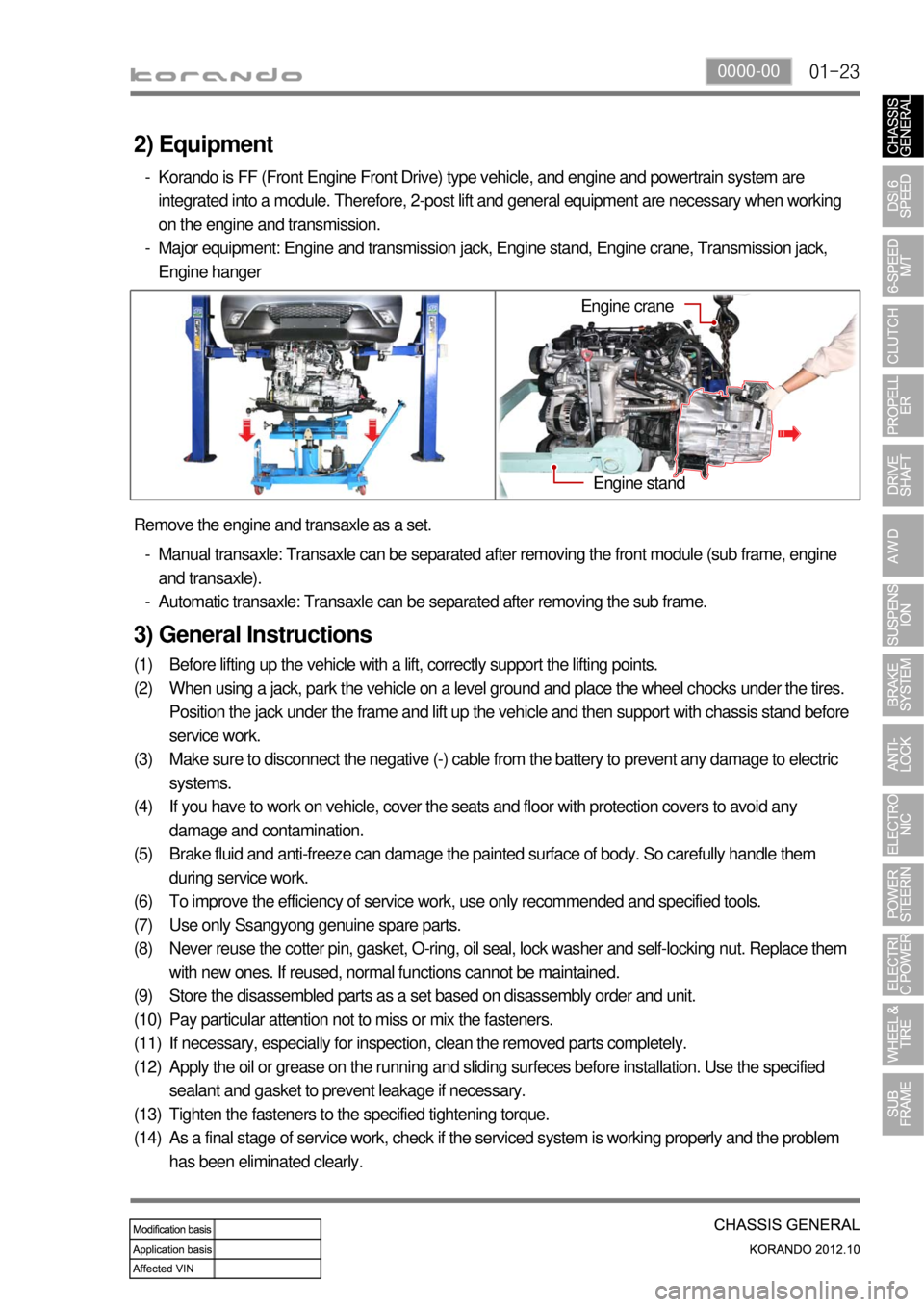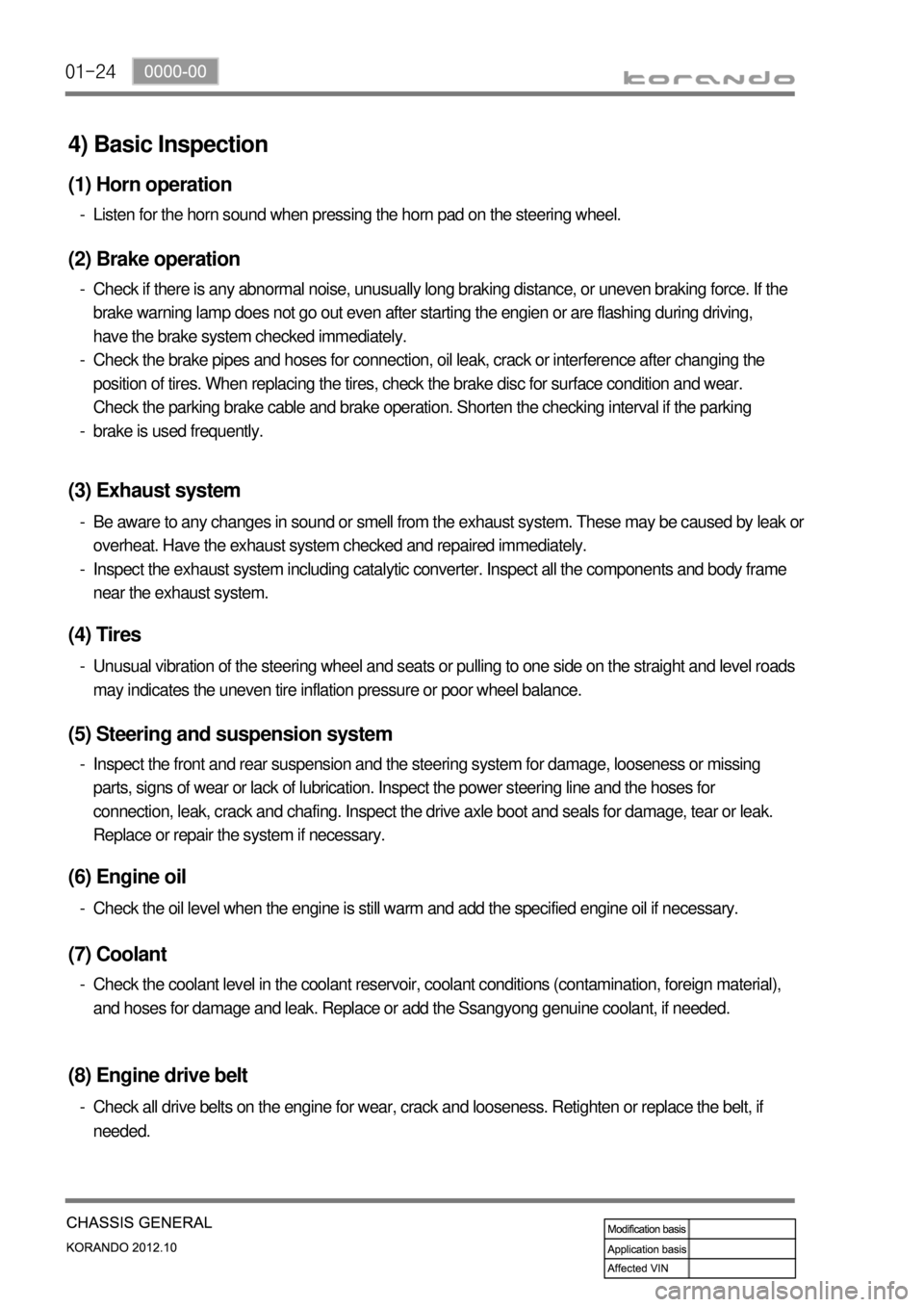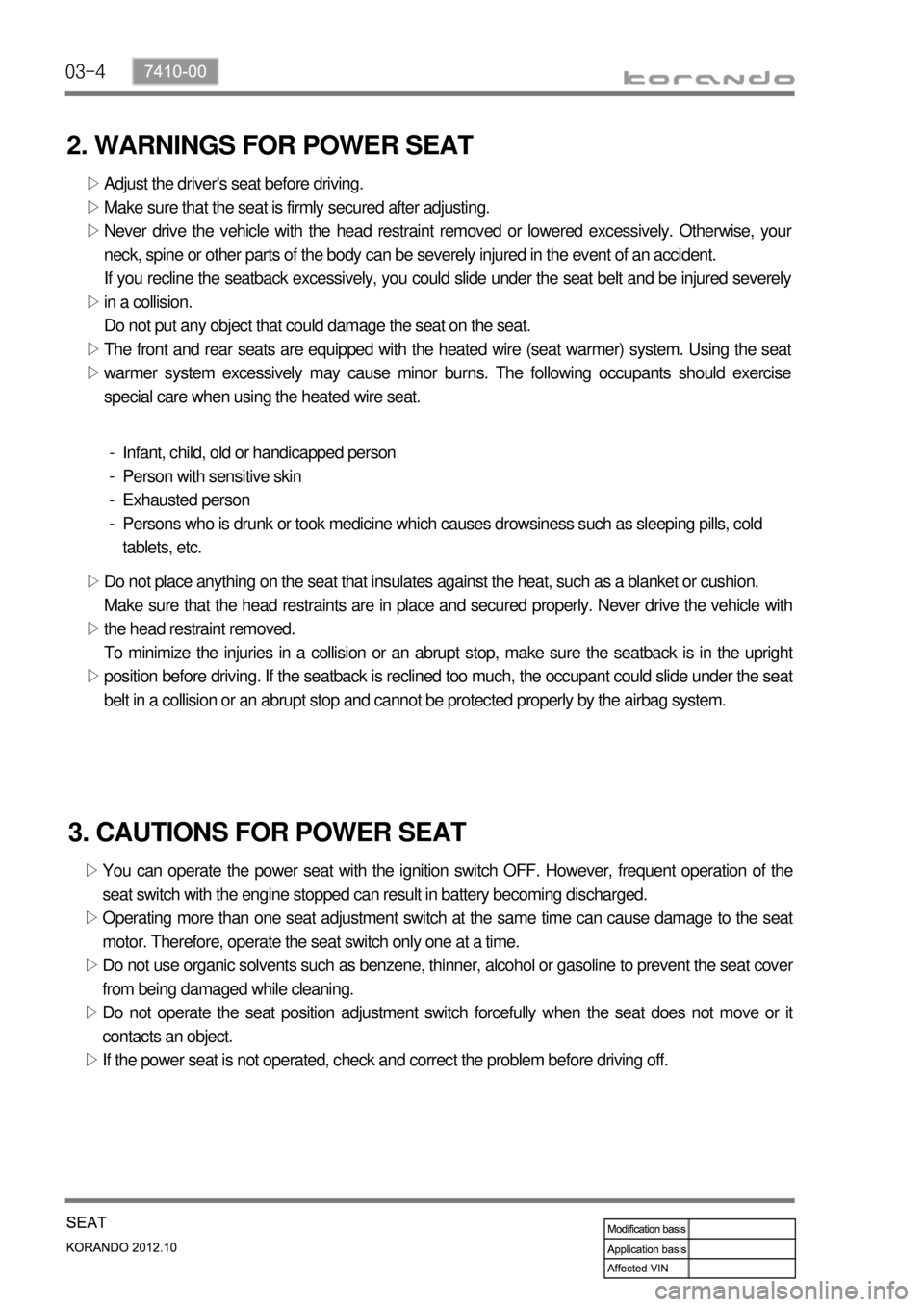check engine SSANGYONG KORANDO 2012 Repair Manual
[x] Cancel search | Manufacturer: SSANGYONG, Model Year: 2012, Model line: KORANDO, Model: SSANGYONG KORANDO 2012Pages: 1082, PDF Size: 96.1 MB
Page 711 of 1082

05-48
Pin No.Message
Operating condition
Domestic Export
Cruise control This message comes on when the ECO cruise mode
is deactivated.
EMSThis message comes on when the engine is faulty.
LampThis message comes on when the tail lamps are ON
with the ignition in the "OFF" or "ACC" position.
SUNROOF
SYSTEMFor the vehicle with SKM, this message comes on
when the sunroof is open with the ignition in the "OFF"
or "ACC" position. For the vehicle without SKM, this
comes on when the sunroof is open with the ignition in
the "OFF" position and the key removed.
Low fuel level This message comes on when the remaining fuel is
insufficient.
ESP checkThis message comes on when the ESP system is
faulty.
ABS check This message comes on when the ABS system is
faulty.
Engine oil level
checkThis message comes on when the engine oil level is
low. Pin No. Message Operating condition
Page 713 of 1082

05-50
5. SELF DIAGNOSIS
1. Self diagnosis for gauge
Speedometer: Check the whole speed range (minimum to maximum).
Tachometer: Check the whole rpm range (minimum to maximum). -
-
2. Self diagnosis for symbols
All symbols ON
(except the wired type symbols: air bag, passenger air bag, turn signal indicators, hazard warning
lamp, high beam, front fog lamp) -
3. ETC
When entering into the self diagnosis mode, the instrument cluster illumination output will be 100%.
All the remaining segments are ON.
The spanner symbol goes off if CAN messages to the instrument cluster are OK. If not, it blinks.
The mode and illumination switch inputs are overridden. -
-
-
-
6. VARIANT CODING
The instrument cluster enables all functions by receiving the vehicle's variant codes through CAN
communication when turning the ignition switch to ON position.
The systems verified by variant code performs the pre-warning and time-out operation. If not
confirmed, all data for the systems, even exiting in CAN network, are overridden. -
- 4. Diagnosis mode deactivation condition
The diagnosis mode is deactivated when the ignition switch is turned to "OFF" position or the
engine is running. -
Page 769 of 1082

08-37810-00
1. WIPER CONTROL
2. CAUTIONS ON RAIN SENSOR
When the wiper switch is in the AUTO position, the wiper will operate for 1 cycle if the initial engine
start is made. This may cause the wiper blades to wear prematurely. Therefore, other than rainy
days, set the switch to the OFF position. Especially during the winter time, check if the wiper blades
are not frozen to the windshield.
Operating the wiper with the blades frozen can damage the wiper motor.
If you operate the wipers when the windshield is dry without spraying washer fluid, the windshield
can be scratched and the wiper blades can wear prematurely. Use the wiper with the washer fluid
when the windshield is dry.
When it does not rain, turn the wiper switch to the OFF position.
Turn the wiper switch to the OFF position before any car wash to avoid unwanted operation of the
wipers. -
-
-
-Wiper mist & washer coupled wiper
Auto washer coupled wiper
Rain sensor coupled wiper operation (LIN)
Speed sensitive intermittent wiper
Wiper low/high control ▶
▶
▶
▶
▶
Check if the sensor is off the position.
Check if the rain sensor cover is securely installed.
Check if the customer is familiar to how to control the wiper sensitivity.
Check if the wiper sensitivity control is set to the FAST side (step 5).
Check the wiper blade for wear.
If the wiper blade cannot wipe the glass uniformly and clearly, it may cause the rain sensor to
work irregularly. Therefore, in this case, replace the wiper blade with a new one. -
-
-
-
- Irregular operation (abrupt operation) ▶ When cleaning the windshield over the sensor with damp clothes, the wiper may operate suddenly. It
could cause serious injury. Make sure to place the wiper switch to the OFF position and ignition switch
OFF when not in use.
Page 833 of 1082

01-230000-00
3) General Instructions
Before lifting up the vehicle with a lift, correctly support the lifting points.
When using a jack, park the vehicle on a level ground and place the wheel chocks under the tires.
Position the jack under the frame and lift up the vehicle and then support with chassis stand before
service work.
Make sure to disconnect the negative (-) cable from the battery to prevent any damage to electric
systems.
If you have to work on vehicle, cover the seats and floor with protection covers to avoid any
damage and contamination.
Brake fluid and anti-freeze can damage the painted surface of body. So carefully handle them
during service work.
To improve the efficiency of service work, use only recommended and specified tools.
Use only Ssangyong genuine spare parts.
Never reuse the cotter pin, gasket, O-ring, oil seal, lock washer and self-locking nut. Replace them
with new ones. If reused, normal functions cannot be maintained.
Store the disassembled parts as a set based on disassembly order and unit.
Pay particular attention not to miss or mix the fasteners.
If necessary, especially for inspection, clean the removed parts completely.
Apply the oil or grease on the running and sliding surfeces before installation. Use the specified
sealant and gasket to prevent leakage if necessary.
Tighten the fasteners to the specified tightening torque.
As a final stage of service work, check if the serviced system is working properly and the problem
has been eliminated clearly. (1)
(2)
(3)
(4)
(5)
(6)
(7)
(8)
(9)
(10)
(11)
(12)
(13)
(14) Remove the engine and transaxle as a set.
Manual transaxle: Transaxle can be separated after removing the front module (sub frame, engine
and transaxle).
Automatic transaxle: Transaxle can be separated after removing the sub frame. -
-
2) Equipment
Korando is FF (Front Engine Front Drive) type vehicle, and engine and powertrain system are
integrated into a module. Therefore, 2-post lift and general equipment are necessary when working
on the engine and transmission.
Major equipment: Engine and transmission jack, Engine stand, Engine crane, Transmission jack,
Engine hanger -
-
Engine stand
Engine crane
Page 834 of 1082

01-24
4) Basic Inspection
(1) Horn operation
Listen for the horn sound when pressing the horn pad on the steering wheel. -
(2) Brake operation
Check if there is any abnormal noise, unusually long braking distance, or uneven braking force. If the
brake warning lamp does not go out even after starting the engien or are flashing during driving,
have the brake system checked immediately.
Check the brake pipes and hoses for connection, oil leak, crack or interference after changing the
position of tires. When replacing the tires, check the brake disc for surface condition and wear.
Check the parking brake cable and brake operation. Shorten the checking interval if the parking
brake is used frequently. -
-
-
(3) Exhaust system
Be aware to any changes in sound or smell from the exhaust system. These may be caused by leak or
overheat. Have the exhaust system checked and repaired immediately.
Inspect the exhaust system including catalytic converter. Inspect all the components and body frame
near the exhaust system. -
-
(4) Tires
Unusual vibration of the steering wheel and seats or pulling to one side on the straight and level roads
may indicates the uneven tire inflation pressure or poor wheel balance. -
(5) Steering and suspension system
Inspect the front and rear suspension and the steering system for damage, looseness or missing
parts, signs of wear or lack of lubrication. Inspect the power steering line and the hoses for
connection, leak, crack and chafing. Inspect the drive axle boot and seals for damage, tear or leak.
Replace or repair the system if necessary. -
(6) Engine oil
Check the oil level when the engine is still warm and add the specified engine oil if necessary. -
(7) Coolant
Check the coolant level in the coolant reservoir, coolant conditions (contamination, foreign material),
and hoses for damage and leak. Replace or add the Ssangyong genuine coolant, if needed. -
(8) Engine drive belt
Check all drive belts on the engine for wear, crack and looseness. Retighten or replace the belt, if
needed. -
Page 1022 of 1082

02-6
Seldom oeprate ▶The air bag deploys when: ▶
The air bag can deploy when: ▶a severe oblique collision occurs with a specific severity, angle, speed, and position. -
A collision with oblique impact to the front seat direction or a front collision to the diagonal
direction occurs.
a frontal or rear collision occurs.
The vehicle rolls over or tips over sideward with minor impact.
The air bag warning lamp is on. -
-
-
-the vehicle rolls over or tips over sideward with a severe impact.
The vehicle is stationary or a front collision occurs with low speed.
A rear collision occurs.
The impact of the collision is low enough for the seat belt to protect the occupant properly. -
-
-
-
Seldom oeprate ▶The air bag deploys when: ▶
The air bag can deploy when: ▶
The air bag does not deploy when: ▶
The vehicle is stationary or a front collision occurs with low speed.
A rear collision occurs.
The impact of the collision is low enough for the seat belt to protect the occupant properly. -
-
-
C. General Warnings for Air Bag
Do not check the circuits with a circuit tester. Do not attempt to modify any air bag component
including the steering wheel, air bag mountings and related wirings.
Do not subject any air bag component, such as the steering wheel, air bag mountings, wirings, to
impacts. You might get severely injured by sudden deployment of the air bag.
As the air bag/seat belt pretensioner parts are very hot after being deployed. Allow them to cool
down sufficiently before touching them.
The deployed air bag/seat belt pretensioner cannot deploy again. It will work when an additional
impact is applied. The components of the deployed air bag/seat belt pretensioner are non-reusable
parts. Therefore, remove or replace them as a unit.
The air bag and seat belt pretensioner systems contain explosive charges, so handle carefully when
disposing or replacing them.
Incorrect inspection can result in serious injuries or malfunctions in the air bag and seat belt
pretensioner system.
The air bag warning lamp is illuminated for 3 to 7 sec. after the engine is started to check the system.
Drive the vehicle after this warning lamp is turned off. If this warning lamp stays ON, the system may
be defective. Have the air bag system checked immediately by Ssangyong Dealer or Ssangyong
Authorized Service Center. -
-
-
-
-
-
-
Page 1037 of 1082

03-4
2. WARNINGS FOR POWER SEAT
Adjust the driver's seat before driving.
Make sure that the seat is firmly secured after adjusting.
Never drive the vehicle with the head restraint removed or lowered excessively. Otherwise, you
r
neck, spine or other parts of the body can be severely injured in the event of an accident.
If you recline the seatback excessively, you could slide under the seat belt and be injured severely
in a collision.
Do not put any object that could damage the seat on the seat.
The front and rear seats are equipped with the heated wire (seat warmer) system. Using the seat
warmer system excessively may cause minor burns. The following occupants should exercise
special care when using the heated wire seat. ▷
▷
▷
▷
▷
▷
Infant, child, old or handicapped person
Person with sensitive skin
Exhausted person
Persons who is drunk or took medicine which causes drowsiness such as sleeping pills, cold
tablets, etc. -
-
-
-
Do not place anything on the seat that insulates against the heat, such as a blanket or cushion.
Make sure that the head restraints are in place and secured properly. Never drive the vehicle with
the head restraint removed.
To minimize the injuries in a collision or an abrupt stop, make sure the seatback is in the upright
position before driving. If the seatback is reclined too much, the occupant could slide under the seat
belt in a collision or an abrupt stop and cannot be protected properly by the airbag system. ▷
▷
▷
3. CAUTIONS FOR POWER SEAT
You can operate the power seat with the ignition switch OFF. However, frequent operation of the
seat switch with the engine stopped can result in battery becoming discharged.
Operating more than one seat adjustment switch at the same time can cause damage to the seat
motor. Therefore, operate the seat switch only one at a time.
Do not use organic solvents such as benzene, thinner, alcohol or gasoline to prevent the seat cove
r
from being damaged while cleaning.
Do not operate the seat position adjustment switch forcefully when the seat does not move or it
contacts an object.
If the power seat is not operated, check and correct the problem before driving off. ▷
▷
▷
▷
▷